Related Research Articles
A drop kick is a type of kick in various codes of football. It involves a player intentionally dropping the ball onto the ground and then kicking it either 'as it rises from the first bounce' (rugby) or 'as, or immediately after, it touches the ground'.

A penalty kick is a method of restarting play in association football, in which a player is allowed to take a single shot at the goal while it is defended only by the opposing team's goalkeeper. It is awarded when an offence punishable by a direct free kick is committed by a player in their own penalty area. The shot is taken from the penalty spot, which is 11 metres from the goal line and centered between the touch lines.

David Roy Akers is an American former professional football player who was a kicker in the National Football League (NFL) for 16 seasons, primarily with the Philadelphia Eagles. He began his career in 1998 with the Washington Redskins, after not making the main roster of the Atlanta Falcons and Carolina Panthers. The following year, he signed with the Eagles, where he spent 12 seasons. Akers was also a member of the San Francisco 49ers and Detroit Lions before retiring in 2013.

In gridiron football, an onside kick is a kickoff or punt deliberately kicked short in an attempt by the kicking team to regain possession of the ball. This is in contrast with a typical kickoff or punt, in which the kicking team kicks the ball far downfield in order to maximize the distance the receiving team has to advance the ball in order to score. The risk to the team attempting an onside kick is that if it is unsuccessful the receiving team gets the ball and usually has a much better field position than with a normal kick.

Gamesmanship is the use of dubious methods to win or gain a serious advantage in a game or sport. It has been described as "Pushing the rules to the limit without getting caught, using whatever dubious methods possible to achieve the desired end". It may be inferred that the term derives from the idea of playing for the game as opposed to sportsmanship, which derives from the idea of playing for sport. The term was popularized by Stephen Potter's humorous 1947 book, The Theory and Practice of Gamesmanship . It had, however, been used before by Ian Coster in his autobiographic book Friends in Aspic, published in 1939, where it was attributed to Francis Meynell.
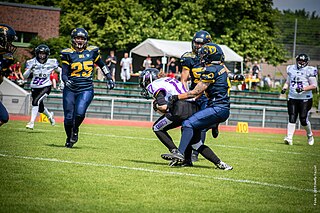
American and Canadian football are gridiron codes of football that are very similar; both have their origins partly in rugby football, but some key differences exist between the two codes.

In sports, a time-out or timeout is a halt in the play. This allows the coaches of either team to communicate with the team, e.g., to determine strategy or inspire morale, as well as to stop the game clock. Time-outs are usually called by coaches or players, although for some sports, TV timeouts are called to allow media to air commercial breaks. Teams usually call timeouts at strategically important points in the match, or to avoid the team being called for a delay of game-type violation, such as the five-second rule in basketball.
Strategy plays a crucial role in American football. Both teams carefully plan various aspects of their gameplay in an effort to win. This includes deciding on formations, selecting players for specific positions, and assigning roles and instructions to each player on offense and defense.
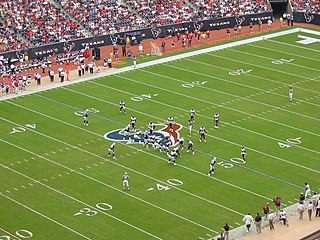
Gameplay in American football consists of a series of downs, individual plays of short duration, outside of which the ball is or is not in play. These can be plays from scrimmage – passes, runs, punts or field goal attempts – or free kicks such as kickoffs and fair catch kicks. Substitutions can be made between downs, which allows for a great deal of specialization as coaches choose the players best suited for each particular situation. During a play, each team should have no more than 11 players on the field, and each of them has specific tasks assigned for that specific play.
In sports strategy, running out the clock is the practice of a winning team allowing the clock to expire through a series of preselected plays, either to preserve a lead or hasten the end of a one-sided contest. Such measures expend time but do not otherwise have a tactical purpose. This is usually done by a team that is winning by a slim margin near the end of a game, in order to reduce the time available for the opposing team to score. Generally, it is the opposite strategy of running up the score.

Wide Right, a.k.a. 47 Wide Right, was Scott Norwood's missed 47-yard field goal attempt for the Buffalo Bills at the end of Super Bowl XXV on January 27, 1991, as described by sportscaster Al Michaels. The missed field goal resulted in the game being won by the New York Giants. The phrase "wide right" has since become synonymous with the game itself, and has since been used in other sports. This game is also called The Miss by some Bills fans.

A comparison of American football and rugby union is possible because of the games' shared origins, despite their dissimilarities.

A field goal (FG) is a means of scoring in gridiron football. To score a field goal, the team in possession of the ball must place kick, or drop kick, the ball through the goal, i.e., between the uprights and over the crossbar. The entire ball must pass through the vertical plane of the goal, which is the area above the crossbar and between the uprights or, if above the uprights, between their outside edges. American football requires that a field goal must only come during a play from scrimmage while Canadian football retains open field kicks and thus field goals may be scored at any time from anywhere on the field and by any player. The vast majority of field goals, in both codes, are placekicked. Drop-kicked field goals were common in the early days of gridiron football but are almost never attempted in modern times. A field goal may also be scored through a fair catch kick, but this is also extremely rare. In most leagues, a successful field goal awards three points.
The following terms are used in American football, both conventional and indoor. Some of these terms are also in use in Canadian football; for a list of terms unique to that code, see Glossary of Canadian football.
Field goal range is the part of the field in American football where there is a good chance that a field goal attempt will be successful.
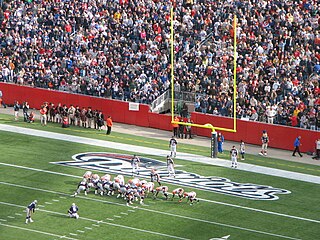
The conversion, try, also known as a point(s) after touchdown, PAT, extra point, two-point conversion, or convert is a gridiron football play that occurs immediately after a touchdown. The scoring team attempts to score one extra point by kicking the ball through the uprights in the manner of a field goal, or two points by passing or running the ball into the end zone in the manner of a touchdown.
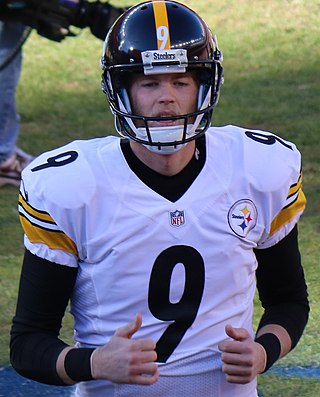
Christopher Lynn Boswell is an American professional football placekicker for the Pittsburgh Steelers of the National Football League (NFL). He played college football at Rice and was signed by the Houston Texans in 2014 as an undrafted free agent and has also spent time with the New York Giants. He is currently the most accurate field goal kicker in NFL history on field goal attempts of 50 yards or more.

The Double Doink was a game-ending field goal attempt by Chicago Bears kicker Cody Parkey in the National Football League (NFL)'s 2018 NFC Wild Card game. Parkey's failed 43-yard field goal attempt against the Philadelphia Eagles was partially blocked by Eagles defensive lineman Treyvon Hester, hit the left upright, then bounced off the crossbar, and finally fell back out onto the goal line finishing on the 3-yard line. The sixth-seeded, defending Super Bowl champion Eagles won the game over the third-seeded Bears, 16–15, at Soldier Field in Chicago, Illinois, and advanced to the Divisional Round of the playoffs.
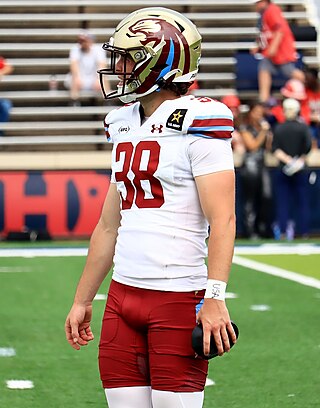
Jake Bates is an American professional football placekicker for the Detroit Lions of the National Football League (NFL). He played college soccer for the Central Arkansas Bears and college football for the Texas State Bobcats and Arkansas Razorbacks. Bates holds the record for the longest field goal in United Football League history, 64 yards.
References
- ↑ Kirshner, Alex (2017-10-20). "How rules for icing kickers differ in college and the NFL". SBNation.com. Retrieved 2022-09-26.
- 1 2 "Icing Kicker: New Tactic Has Drawn Double Take" The New York Times , 21 October 2007
- ↑ Kasabian, Paul. "Video: UFL's Jake Bates Kicks 64-Yard Game-Winning FG for Panthers vs. Battlehawks". Bleacher Report. Retrieved 2024-04-01.
- ↑ Berry, S., and C. Wood. 2004. The cold-foot effect. Chance 17(No. 4):47-51.
- ↑ Peterson, Ivars. "Icing the Kicker Archived 2009-03-02 at the Wayback Machine " Muse (September 2005)
- ↑ Peterson, Ivars. The Iced Foot Effect MathTrek (November 15, 2004) Archived 2004-11-17 at the Wayback Machine
- ↑ Birnbaum, Phil. "And (sic) old 'icing the kicker' study" Sabermetric Research (January 6, 2008)
- ↑ Zimmerman, Paul. "Icing on the cake" Si.com (January 21, 2005)